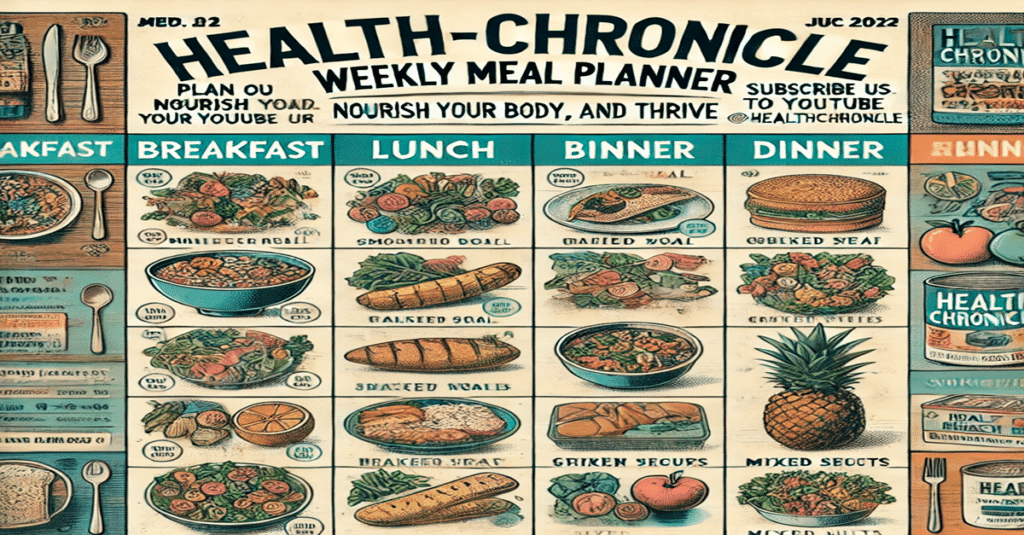Using Meal Planner: A Guide to Simplify Your Life and Eat Healthier
An easy to use Meal Planner Template is attached at the end of this article for your use. Planning your meals isn’t just about saving time—it’s a transformative habit that can help you eat healthier, reduce food waste, and save money. With a little organization and creativity, meal planning can become an enjoyable routine. This guide will walk you through key strategies, including weekly grocery planning, growing your own food, and managing your shopping list effectively.
Why Plan Your Meals?
Do we even need to answer this question. Anyways you can watch the YouTube video below for some inspiration by clicking here.
Step 1: Weekly Planning for Grocery Shopping
A well-thought-out weekly meal planer is the backbone of effective meal preparation. Here’s how to do it:
Save Time: Spend less time deciding what to cook each day.
Eat Healthier: Stick to balanced meals and avoid last-minute unhealthy choices.
Reduce Waste: Buy only what you need and use everything you purchase.
Save Money: Prevent impulse buys and unnecessary takeout expenses.
A. Assess Your Schedule
Review your week ahead. Are there busy nights where you need quick meals? Or quieter evenings for elaborate recipes?
Plan meals accordingly—simple options for busy days and creative dishes when you have more time.
B. Plan a Balanced Menu
Include all major food groups: proteins, grains, vegetables, fruits, and healthy fats.
Try themes like “Meatless Mondays” or “Taco Tuesdays” to make planning fun and easy.
C. Batch Cooking and Leftovers
Choose recipes that can be cooked in large quantities and reused for lunches or dinners.
For example, a roasted chicken can serve as a main dish one night and be used for salads or sandwiches the next day.
D. Build a Weekly Meal Plan
Write down meals for each day of the week.
- Example
Write down meals for each day of the week.
Monday: Grilled chicken, roasted vegetables, quinoa.
Tuesday: Pasta with tomato sauce and side salad.
Wednesday: Stir-fried tofu with rice and broccoli.
Keep it flexible to adjust for cravings or unexpected changes.
Step 2: Grow Your Own Food
Growing your own food, even in small quantities, is a fantastic way to enhance your meal planning. Start with easy-to-grow options like microgreens or herbs.

Why Grow Your Own Food?
Freshness: Enjoy ultra-fresh ingredients picked right before cooking.
Cost-Effective: A small packet of seeds can produce many servings.
Sustainable: Reduce reliance on store-bought items and their packaging.
How to Grow Microgreens
Microgreens are nutrient-packed plants harvested when they’re still young. Here’s how to grow them at home:
Choose Seeds: Popular options include sunflower, radish, and broccoli.
Prepare a Tray: Use a shallow tray with drainage holes. Fill it with a light potting mix.
Plant Seeds: Sprinkle seeds evenly across the soil and lightly press them down.
Water and Care: Mist the seeds daily and ensure they get indirect sunlight.
Harvest: In 7–14 days, when the plants are 1–2 inches tall, snip them with scissors.
Other Easy-to-Grow Options
Herbs: Basil, parsley, mint, and cilantro thrive in small spaces.
- Salad Greens: Lettuce, arugula, and spinach grow quickly and are perfect for small gardens or pots
Step 3: Start and Maintain a Shopping List
An organized shopping list is essential for sticking to your meal plan and avoiding unnecessary purchases.
How to Create a Shopping List
Categorize by Aisle:
Group items by section: produce, dairy, grains, frozen, etc.
Prioritize Essentials:
List must-haves for your planned meals first, then add optional extras.
Check Your Pantry:
Before heading out, review what you already have to avoid duplicates.
Keep It Updated
Use a whiteboard, app, or notebook in your kitchen to jot down items as you run out.
Sync your list with family members to ensure nothing is missed.
Pro Tip: Use Technology
Apps like AnyList or Google Keep make it easy to manage and share your list.
Putting It All Together
Here’s an example of how meal planning, growing your food, and managing your shopping list work in harmony:
Meal Plan:
Monday: Stir-fry with broccoli microgreens.
Tuesday: Salad with homegrown lettuce and basil.
Grocery List:
Chicken, tofu, rice, tomatoes, cheese, carrots, and olive oil.
Growing Food:
Use microgreens and herbs from your indoor garden to complement meals.
Batch Cooking:
Prepare extra stir-fry for Tuesday’s lunch.
Tips for Long-Term Success
Start Small: Don’t overwhelm yourself with elaborate plans or too many new recipes at once.
Be Flexible: Allow room for spontaneous changes.
Get the Family Involved: Let everyone suggest meals and help with preparation.
Celebrate Wins: Enjoy the benefits of less waste, healthier eating, and time saved.
The Bigger Picture
Meal planning is about more than just eating well—it’s a mindful approach to your lifestyle. By growing some of your own food and keeping a smart shopping list, you can simplify your routine, improve your health, and contribute to a more sustainable future.
So, why wait? Start planning your meals today and reap the rewards of a healthier, more organized life! 🌱🛒
We would like to encourage you to use a meal planner as below to start your Journey. You can easily download this meal planner and print it for your use.




